 “Awk, there’s crick in my left shoulder,” I said to Keith. I grabbed the shoulder with my right hand then massaged and shifted it one way and another trying to work out the crick. “If I could just get it to click back into place, everything would be fine, you know?” We had been loading logs from the lower woodpile into the truck and moving them to an upper woodpile for this winter’s use.
“Awk, there’s crick in my left shoulder,” I said to Keith. I grabbed the shoulder with my right hand then massaged and shifted it one way and another trying to work out the crick. “If I could just get it to click back into place, everything would be fine, you know?” We had been loading logs from the lower woodpile into the truck and moving them to an upper woodpile for this winter’s use.
Why’s this happening? I wondered. I exercise almost every day. I’m in good shape.
“Hold your arms out and circle them forward then back, starting small and increasing the diameters,” Keith suggested. When I tried that strategy, pain shot down my left arm to the funny bone. My fingers tingled as if numb.
“Ah, now I know what’s wrong,” I said. It was the old ‘symptom in one place, problem in another’ deal, like I had with my lower back. I needed to do more neck stretches.
As I get older, I find that of the three types of exercise – stretching, aerobics, weights – stretching is the most important. I’ve never been particularly limber. Thus when problems have surfaced, I’ve consulted a chiropractor for targeted stretching advice.
The shoulder crick reminded me of the following Misconceptions:
- I am prepared to do something I have not done in a year.
- Implementing a strategy that addresses the symptom will solve the problem.
- The problem is in the same place as the symptom.
Preparation: Although there are some things I do only once a year or even less frequently, regular and targeted exercise is key. I suspect this is true for all aspects of our lives: physical, intellectual, spiritual, social and global. Less-used muscles and skills need stretching and practice, too.
Strategy: Writer and management consultant Peter Drucker said, “Culture eats strategy for breakfast.” (There are days when I might say the same about Aging.) Drucker’s point is this: a narrow-lens strategy that ignores culture will fail. And, as in my case, the strategy might even make the problem worse.
Problem: “As we age, either imagination overtakes memory or memory overtakes imagination,” wrote Mark Batterson in The Circle Maker. “Imagination is the road less taken, but it is the pathway of prayer.” (42) If we look beyond our symptoms and memories, and thus choose a wider lens, we can use imagination to set higher goals. As Batterson’s subtitle notes, we can pray circles around our dreams.
How are you stretching?



0 Comments